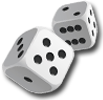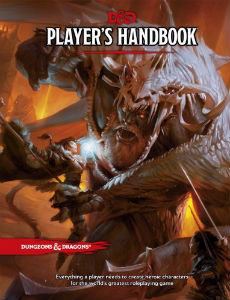



play board games
Board game reviews, strategy tips & session reports
D&D 5e Player’s Handbook Review
 The Dungeons and Dragons Fifth Edition (5e) Player’s Handbook has all the information you need to create characters and start adventuring.
The Dungeons and Dragons Fifth Edition (5e) Player’s Handbook has all the information you need to create characters and start adventuring.
D&D 5e Player’s Handbook Description:
The DnD 5e Player’s Handbook starts by giving a brief introduction on roleplaying games, how to use the Player’s Handbook and some general rules like rounding down and advantage and disadvantage. I covered some of these things in my review of the Starter Set here.
Next they take you through the steps of creating a character and the rules of adventuring, combat and spellcasting.
To create a character you first must choose their race. There are four common races, dwarf, elf, halfing and human, and five that are uncommon, dragonborn, gnome, half-elf, half-orc and tielfling. Just how uncommon the uncommon races are is up to your DM. Many of the races have sub-races and get a +2 and +1 ability modifier. Each race also has traits, abilities, size and speed.
After choosing a race you select a class. There are 12 different classes including barbarian, bard, cleric, druid, fighter, monk, paladin, ranger, rogue, sorcerer, warlock and wizard. Each class has different paths or sub-classes you can choose. These let you hone your character and make it possible for two characters of the same class be unique.
Your character’s background, personality, ideal, and flaw are fleshed so you can have them more defined and so you can gain inspiration. You gain inspiration by roleplaying your personality traits or giving into your flaws. You can use inspiration to get advantage on a roll. But may only ever have one point of inspiration. You can also give your inspiration to another PC if they do something clever, daring or fun.
Feats are an optional rule in 5e and if used may be taken instead of taking an ability increase. Feats represent an expertise your character has and gives you a special ability or bonus.
The next section of the book deals with playing the game. Combat is not too different from older versions, but a couple things haves changed. You can no longer take a five-foot step or shift. If you want to get out of melee combat without provoking an attack of opportunity, you must take a disengage action. The disengage action lets you move but not attack. Also if you attack with a range weapon or spell while in melee you have disadvantage.
Spellcasting is pretty different with your spellcaster having spell slots of different levels based on its level. You can also have only certain number of spells prepared from those you know each day. But you can cast any of those prepared spells. This is similar to the 3e sorcerer. The new sorcerer gains sorcery points you can use to buy extra spell slots. At higher levels you can use sorcery points to enhance your spells. You can also cast spells in armor if you are proficient with it.
Quick Review of the D&D 5e Player’s Handbook:
The 5e Player’s Handbook looks great. The layout and design is top notch and the art looks great.
The changes really open things up a lot and grant more freedom to DMs and players. The rules are fairly modular and you can use those you like and ignore or remove the ones you don’t fairly easily.
There is even flexibility in how you play the game. You can use a grid or not. It is up to you and your group.
5e really feels like the best from 2e, 3e and 4e. The combination of some of the best things from the old editions and the streamlining of some of the rules and math make this edition great for old and new players. The Player’s Handbook expands on the information from free pdf of the Basic Rules and the 5e Starter Set. If you plan to play 5e Dungeons and Dragons you should pick this up or at least have one of these in your group.

How do you feel 5E holds up to the more narrative systems like Dungeon World, etc?
I think it has room for it, but I say that never having played Dungeon World.